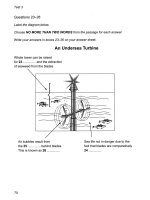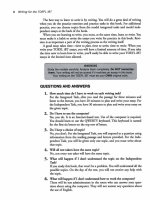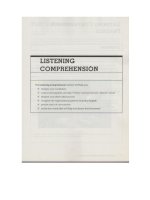ENGLISH FOR AGRICULTURAL ECONOMICS - PART 2 potx
Bạn đang xem bản rút gọn của tài liệu. Xem và tải ngay bản đầy đủ của tài liệu tại đây (136.89 KB, 10 trang )
9
UNIT 2
THE BUSINESS CYCLE
(Extracted from English in Economics and Business, Ha Noi Economics University, NXBGD)
In groups, discuss what you know about the business cycle.
Read the following text
Income growth fluctuates up and down over time even when there is a generally
rising trend in output. For example, in Vietnam, national income grew at an average
annual rate of 3.9% per year between 1986 and 1990. But rates varied significantly
from one year to the next. In 1986 income grew 6.5%, much more than average growth
rate from 1986-1990.
In 1990 it only grew 2.4% which was less than the average. These year-to-year
(or short-term) movements in output are called the business cycle.
The business cycle is the somewhat regular pattern of expansion (recovery) and
contraction (recession) in real output of the economy that happens over the long term.
The turning points of economic activity during the business cycle are the peak
and the trough. The peak occurs when the growth rate is at the highest point and
unemployment is low. The trough occurs when growth rate is at the lowest point and
when unemployment is high.
The business cycle has two phases defined by the peak and the trough. The
recession, (or contraction) is the period from the peak in cyclical activity to the trough,
or bottom. The recovery, (or expansion), is the move up to the next peak. Business
cycle are irregular both in the period of time they last, and in the magnitude (size) of
the cycle. Macroeconomic policies try to stable the economy and reduce the size of the
fluctuations from the business cycle.
10
* Comprehension questions
1. Answer the following questions:
1. What was the annual rate of national income growth in Vietnam between 1986
and 1990?
2. Was this rate the same every year?
3. What are short-term movements in output called?
4. What is the business cycle?
5. What does growth usually refer to in economics?
6. What are the two turning points in the business cycle called?
7. What are the two phases defined by?
8. What are the two phase called?
9. What do macroeconomics policies try to do with regard to business?
* Vocabulary exercises
2. What words or phrases in the reading passage have the same meaning as:
1. yearly
2. the highest point
3. the lowest point
4. size
5. contraction
6. expansion
7. to move
8. short-run
3. Fill in the blanks with suitable words from the text:
1. The inflation ………… is very low this year compared to last year
2. She has a very ……………….schedule; I never know when she will be in
class or in her office.
3. The temperature can …………from 32 degrees to 40 degrees in one day
during the summer.
11
4. The………… of the mountain is very high and it would take 3 days to walk
up there.
5. Her quick ……….from illness surprised even the doctors.
6. They made plans for an……………… of the business into some new fields
like computers and communication equipment.
7. In the …………… output cannot expand very much because no new
machines can be bought.
8. It is hard to………… a farmer‟s income because the weather has such a big
effect on it and we can‟t control the weather.
9. He is ……………… richer than his sister because their parents only sent their
son to the university.
10. His …………monthly expenditures are $70 although sometimes they are
only $40 and sometimes they can reach $149
11. He…………… inflation as the increase in the general price level that occurs
over time.
12. The buying………… of young people are different from those of old people
since young people tend to buy more clothes, tickets for movies, and ice cream while
older people need to buy more medicine and household goods.
13. There was a significant………….in demand for pork when people heard that
it was bad for their health.
14. In this graph we can see a………………when his income dropped to the
lowest point.
15. Most children go through a …………….when they don‟t want to listen to
what their parents said.
12
* Writing
Write a short essay to describe the graph below that shows the production of
rice, rubber, tea and pepper in 1987,1988 and 1989
0
10
20
30
40
50
60
70
80
90
rice rubber tea pepper
1987
1988
1989
* Translation
1. Translate the text into Vietnamese
2. Translate into English:
PHÁT TRIỂN SẢN XUẤT CHÈ Ở VIỆT NAM
1.Theo số liệu của tổ chức lương thực và nông nghiệp thế giới, Việt Nam là một
trong 20 nước sản xuất nhiều chè trên thế giới.
2. Diện tích đất đai có thể trồng chè ở Việt Nam là 300,000 hécta và được phân
bố trên gần 30 tỉnh. Trong đó miền trung du và miền núi phía bắc có khoảng 200,000
hecta, vùng tây nguyên khoảng 70,000 ha, vùng khu bốn cũ khoảng 20,000 hecta.
3. Diện tích chè đã trồng đến cuối năm 1993 là 66,000 hecta.
4. Sản lượng chè búp tươi là 170,000 tấn tương đương với 34,000 tấn chè búp
khô.
5. Sản lượng chè xuất khẩu đạt 14,000 tấn
13
6. Khả năng phát triển cây chè ở Việt Nam còn rất lớn nhưng chưa đựoc khai
thác hết vì thiếu vốn để xây dựng các vườn chè mới, chăm sóc các vườn chè đã có, xây
dựng đường sá đến các vùng trồng chè, đến các xí nghiệp chế biến chè.
7. Theo kế hoạch phát triển kinh tế xã hội 1991-1995, diện tích chè đựoc trồng
thêm là 30,000 hecta, để đến năm 1995 tổng diện tích chè toàn quốc là 90,000 hecta và
đến năm 2000 tổng diện tích chè là 140,000 hecta, trong đó diện tích có thể thu hoạch
là 100,000; sản lượng chè búp khô 90,000 tấn (có 50,000 tấn xuất khẩu)
8. Việc trồng chè không những tạo thêm việc làm, mang lại thu nhập ngoại tệ mà
còn có tác dụng phủ xanh đồi trọc, chống xói mòn, bảo vệ đất, cân bằng môi trường
sinh thái
9. Do đó, đây là một nghành kinh tế được nhà nước Việt Nam khuyến khích phát
triển
3. Translate into Vietnamese
1. Since our country carried out the business revolution, the Vietnamese economy has
never experienced as forceful changes in many aspects as in the year 2003.
2. Gross Domestic Product increased 7,5% as compared to 2002, ranking 4
th
for
economic development rate in South- East Asia- the region having highest
development rate in the world in the past year.
3. 24,5 million tons of food were produced, the value of total agro-production
increased 3% of that of the previous year.
4. 1,8 millions tons of rice were exported, keeping Vietnam fast at its 3
rd
rank among
the biggest suppliers in the world.
5. The particularly important fact was that Vietnamese economy has been overcoming
recession with continual growing steps in the past three years and it has entered a new
phase of socio-economic development since 2003
14
* Grammar Review
Inversion
1. If we had known your address, we would have visited you.
Had
2. It was so interesting a story that he couldn't stop reading.
So
3. John hardly remembers the accident that took his sister's life.
Hardly
4. He was able to make himself heard only shouting
Only………………………………………………………………………………
5. He became so suspicious that he didn‟t believe in whatever his wife had said
to him.
So………………………………………………………………………………
6. They not only rob him, they smash everything too.
Not only……………………………………………………………………
7. He didn‟t realize that he had lost the wallet till he got home
Not till………………………………………………………………………
8. The truth only came out on the publication of the general‟s person diaries
Only when……………………………………………………………………
9. I‟ve never seen such a mess in my life
Never……………………………………………………………………
10. There is always trouble when he comes to visit us
Whenever……………………………………………………………………
15
* More exercises
Read the text carefully the fill in the blanks, using the words given
help began should Assistant Manager
became
to promote demanded made commercial
Information-processing broke profit management
Thomas J. Watson Senior ( 1) his business career as a sewing machine
salesman and later, when he (2) the President of IBM, he used his sales
techniques (3) the company‟s name.
When Watson joined IBM in 1914, the company was almost (4) Under
his leadership, it grew beyond all expectations, and established a leading position in
(5) industry.
Watson believed that the way to win a man loyalty is to build up his self-respect.
So under his (6) , IBM employees earned above-average salaries and good
pensions. In turn, he (7) loyalty and enthusiasm. Everyone worked long
hours.
Watson had a strong personality and (8) all the major decisions himself
. He thought that a manager (9) be an assistant to men, and IBM ran no
management training schools in his day. The only advice he gave was: “ You‟ve
promoted to (10) . Be careful with people, don‟t swear, and wear a white
shirt”.
16
UNIT 3
VIETNAM AGRICULTURE
ACHIEVEMENTS AND DEVELOPMENT RIENTATION
(Extracted from ./en/stories/sectors.asp)
In groups, discuss Vietnam agriculture in recent years. What sector of
Vietnam agriculture do you think it has changed most? Then, compare with
the following text.
Read the following text
Taking off from an agricultural economy Vietnam agriculture has accounted for
30% of export value and 25% of total national GDP. 76% of population is now living
in rural areas. In 1997/1998 period, agriculture, forestry and fishery sector created jobs
over 66% of national labor force. Nominal income of rural people has increased by
12% a year from 92/93 to 97/98 with the agricultural contribution of 81%. Agricultural
and rural development is considered a foundation for general economic development
and the implementation of modernization and industrialization.
Renovation in agriculture is the kick-start for Vietnam economic reform, creating
solid background for economic development. Prior to 1988, food security in Vietnam
was not fully assured, domestic demand could only be met by importing food from
international markets. But in 1990-1999, agriculture sector has experienced great
progress with average growth rate of 4.5% year, thanks to right policies on allocating
land use right to farmers, developing household economy, liberalizing trade,
developing rural credit and providing extensions services.
Over the last ten years, food output has increased averagely 1.2 million tons/year.
Rice export in 1999 was 4.5 million tons. Cultivation and livestock sectors have
developed in the direction of diversifying products and improving efficiency of land
and labor. Specialized zones for several main industrial crops have been established in
great number. Output of coffee, rubber, tea and sugar gained 400, 200, 65, thousand
tons respectively. Fruit area is about 450 thousand ha with estimated output of 4.5
17
million tons. Growth rate of livestock sector is 5-6%/year. In 1999, total meat
production attained 1.75 million tons, 7.7% higher than 1998 figure.
While the production of livestock products, sugar, fruit and vegetable and etc is mainly
for satisfying domestic market demand, many others are for export at high rate such as coffee
(95%0, cashew (90%), rubber (80-85%), pepper (90%), tea (50%) and etc. form the country in
serious shortage of food, Vietnam becomes the second largest rice exporter, the second
Arabica coffee exporter, the forth cashew biggest exporter in the world. In 1999, agricultural
export volume was estimated at 3.25 billion USD, an increase of 11%.
Agricultural and rural economic structure has initially changed towards sector
and crop diversification, making contribution to transformation national economic
structure in the direction of increasing proportion of industry and services. There are
now nearly 12 million households in rural areas, including 10 million involving in
agricultural production (equivalent to 80.6%). In agricultural sector, the structure of
cultivation and livestock changed in the direction of decreasing cultivation proportion
(77.6%) and raising livestock ratio (22.5%) while absolute value of each sector has
increased. Crop structure has been diversified; food crops monoculture has been
rejected to improve soil efficiency. Livestock sector has been transformed towards
increasing quantity and ratio of commercial cattle and milk.
* Comprehension questions
1. Work in pairs, answer the following questions:
1. How many percentages has Vietnam agriculture accounted for export value
and for total national GDP?
2. What is agricultural and rural development considered?
3. What is the kick-start for Vietnam economic reform?
4. How could domestic demand in Vietnam prior to 1988 be met?
5. What was the average growth rate of agriculture sector?
6. What did agricultural sector in 1990-1999 experienced great progress thanks to
?
7. How many tons of rice was exported in 1999?
18
8. What is the growth rate of livestock sector per year?
9. Does Vietnam become the third largest rice exporter?
10. How has soil efficiency improved?
2. These statements are True (T) or False (F)
………1. In 1997-1998 period, agriculture sector created jobs for over 66% of
national labor force.
………2. Agricultural and rural development is considered a foundation for
general economic development.
………3. Investment and the growth of industry is basis for Vietnam economic
reform.
……….4. Specialized zones for several main industry sector have been
established in great number over the last 10 years.
……….5. In 1999, total meat production attained higher than 1998 figure.
……….6. In 1999, there was a decrease in agricultural export volume.
* Vocabulary exercises
1. Fill in the blanks with the words from the text
1. The state of the domestic……………is very worrying.
2. ………….production has rapidly increased in recent years.
3. My college is closed for…………… because it is very old.
4. The average ………… of the factory is 20 cars a day.
5. …….for skilled workers is high; but there was no ………for unskilled ones
6. Tax is payable on all………………………over $ 2000.
7. The signing of such a treaty would be a major ……………… towards world
peace.
8. Imperfect articles are ……………… by our quality control.
9. She used to be terribly shy, but a year abroad has completely…… her.
10. Vietnam has a ……… of people









